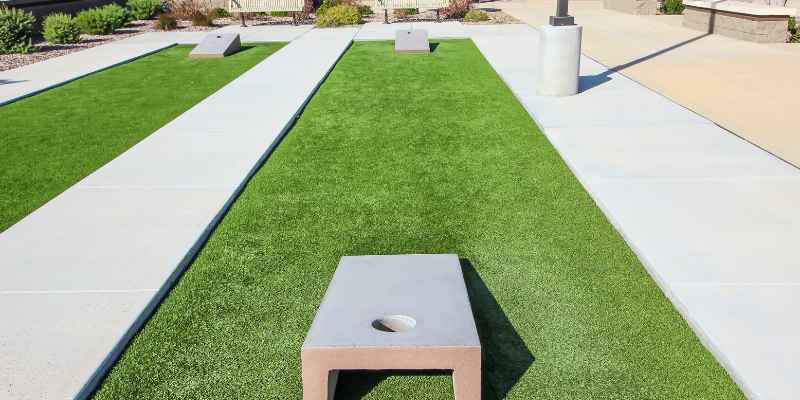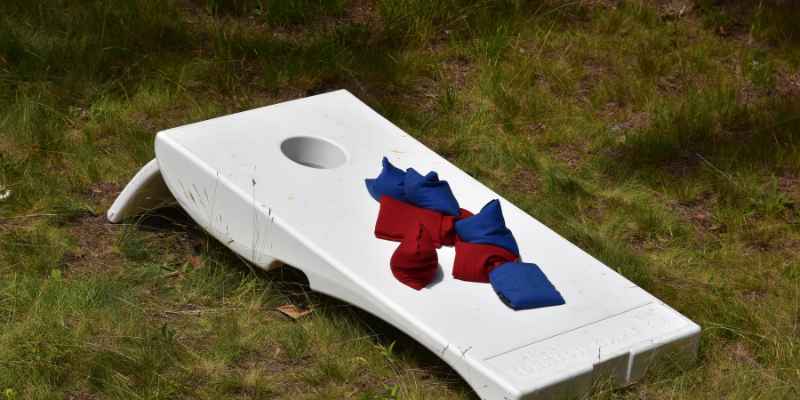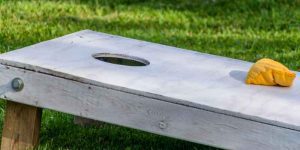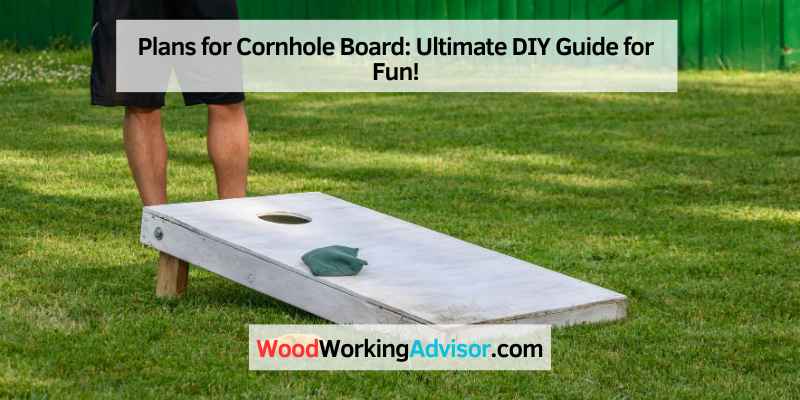For building cornhole boards, you need a detailed plan with precise measurements and materials list. This ensures durability and gameplay accuracy.
Cornhole is a popular outdoor game enjoyed by all ages. Crafting your own cornhole board can be a rewarding DIY project. Accurate plans are essential to ensure your boards meet official regulations, promoting fair play. Begin by gathering the necessary materials: plywood, two-by-fours, screws, and paint.
Cut the plywood to 48×24 inches for the board’s surface. Use two-by-fours to construct the frame and legs. Ensure the hole is 6 inches in diameter, centered 9 inches from the top. Sand the surfaces for a smooth finish. Finally, paint or customize your boards to reflect your personal style. Enjoy countless hours of fun with your custom-made cornhole boards.
Introduction To Cornhole
Crafting your own cornhole board can be a rewarding project. Detailed plans ensure a sturdy, professional-quality game setup. Enjoy customizing your board with personalized designs.
A Brief History
Cornhole is a popular outdoor game. It started in the United States. People love playing it at parties. The game uses two boards and bean bags. Players throw bags into holes on the boards. Cornhole has simple rules. It can be played by all ages. The game is also known as “bags” or “baggo”. Cornhole is fun and easy to learn.
Why Build Your Own?
Building your own cornhole board is fun. It saves money too. You can choose your own design. Custom boards look unique. It is a great DIY project. Building it is not hard. You need some basic tools. The boards can be made in a day. Friends and family will enjoy it. You will feel proud of your work.

Materials Needed
Gather plywood sheets, 2×4 lumber, wood screws, and wood glue. Include a measuring tape, saw, drill, and sandpaper.
Types Of Wood
Use plywood for the board surface. Plywood is strong and smooth. Choose two-by-fours for the frame. They give good support. Pine wood is also a good choice. It is light and easy to work with.
Hardware Components
Gather screws and nails for assembly. Use wood glue for extra strength. Choose hinges if you want foldable legs. Use washers and bolts for moving parts. Sandpaper is needed for smooth edges.
Paints And Finishes
Select outdoor paint to protect the wood. Use primer before painting. It helps paint stick better. Choose a clear coat finish for shine. Finishes also protect from scratches. Paint can be in any color you like.
Designing Your Cornhole Board
The board should be 48 inches long. Make it 24 inches wide. The hole should be 6 inches in diameter. Place it 9 inches from the top. Keep it centered. The front edge should be 3-4 inches off the ground. The back edge should be 12 inches off the ground. These measurements are standard for cornhole boards.
Use bright colors for a fun look. Paint patterns or images you like. Add your name or logo. Use stencils for clean designs. Seal the board to protect your art. Try different shapes for the hole. Use LED lights for night play. Smooth the surface for better sliding. Add handles for easy carrying.
Step-by-step Construction Process
First, gather all your materials. You need wood pieces, a saw, and a measuring tape. Measure the wood carefully. Mark the spots where you will cut. Use the saw to cut the wood pieces to size. Make sure the cuts are straight. Safety goggles are important while cutting.
Lay the cut wood pieces on a flat surface. Arrange them to form a rectangle. Use screws to attach the corners. Make sure each corner is secure. The frame should be sturdy and even. Double-check your work.
Place the plywood on top of the frame. Make sure it fits well. Use screws to attach the plywood. Start at one corner and work around. Ensure the surface is smooth and flat. Check all screws are tight.
Sanding And Painting
Use a fine-grit sandpaper for smooth surfaces. Sand in the direction of the wood grain. Make sure to remove all dust. Use a damp cloth to wipe clean. Repeat sanding if needed for a smoother finish.
Select a paint suitable for wood. Acrylic paint works well for cornhole boards. Choose colors that match your design. Make sure the paint is weather-resistant. Apply a primer before painting for better results.
Use stencils for precise graphics. Apply the stencil and paint carefully. Remove the stencil once dry. Seal the paint with a clear coat. This protects the design and adds shine.
Creating The Cornhole Bags
Choose a durable fabric. Cotton or canvas works well. Bright colors look nice. Patterns are fun too. Ensure the fabric is strong. It should resist wear and tear. Wash the fabric before use. This removes any shrinkage. Cut the fabric into squares. Each square should be 7×7 inches.
| Material | Pros | Cons |
|---|---|---|
| Plastic Pellets | Waterproof | Can be expensive |
| Corn Kernels | Traditional feel | Can attract pests |
| Sand | Easy to find | May leak |
Place two fabric squares together. Ensure the right sides face each other. Sew around the edges. Leave a small gap. Turn the bag inside out. Fill the bag with your chosen material. Sew the gap closed. Double-stitch for strength. Repeat these steps for each bag. Make sure all bags weigh the same.
Maintenance And Care
Use a soft cloth for cleaning. Avoid harsh chemicals. Clean with mild soap. Dry the board completely after cleaning. Store in a dry place.
Store the board indoors. Keep it away from direct sunlight. Use a cover to protect it. Store in a cool, dry place. Avoid stacking heavy items on it.
Game Rules And Scoring

Cornhole board plans come with specific game rules and scoring methods. Players aim to score by tossing bags into the board’s hole or landing them on the board. Points vary depending on where the bag lands, ensuring competitive and engaging gameplay.
Basic Gameplay
Cornhole is a fun game. Players throw bags at a board. The board has a hole. The goal is to get the bag in the hole. Each player gets four bags. Players take turns throwing one bag at a time. Stand behind the board’s front edge. Do not step over the line while throwing. After all bags are thrown, count the points. The game continues until one player wins.
Scoring System
Points are easy to count. A bag in the hole scores three points. A bag on the board scores one point. Bags on the ground score zero points. Subtract the lower score from the higher score. The difference is the points for that round. The first player to reach 21 points wins. Winning can be exciting.
Enhancements And Accessories
Scoreboards help keep track of the game. They are easy to use. Some are made of wood. Others are made of plastic. You can hang them on the board. Some come with clips for easy attachment.
Playing at night is fun. Lights help you see the board. LED lights are popular. They use less power. You can attach them easily. Some lights are battery-powered. Others need a power source.
Carrying cases make transport easy. They protect your board. Most cases are made of durable fabric. Some have handles for easy carrying. Others come with wheels. Choose a case that fits your board.
Cornhole Tournaments And Community
Start by searching online for cornhole leagues. Many communities have local leagues. Social media is a good place to find them. Local parks often host cornhole games. Ask friends if they know any local leagues. Check community centers for cornhole events. Libraries sometimes have bulletin boards with event info. Visit local sports stores and ask about cornhole leagues.
First, choose a good location for the event. Parks or big backyards are great. Set a date and time for the tournament. Make sure to have enough cornhole boards. Create a sign-up sheet for players. Decide on rules and prizes for winners. Advertise your event on social media. Invite friends and family to join. Prepare food and drinks for guests. Set up the boards and start the games. Have fun and enjoy the community spirit.

Frequently Asked Questions
What Materials Are Needed For Cornhole Boards?
You’ll need plywood, 2×4 lumber, screws, and paint. These materials ensure durability and a smooth playing surface.
How To Make Regulation-size Cornhole Boards?
Cut plywood to 48×24 inches. Build a frame with 2×4 lumber. Attach the plywood, ensuring the hole is 6 inches in diameter.
What Tools Are Required For Building Cornhole Boards?
You’ll need a saw, drill, measuring tape, and sandpaper. These tools help in precise cutting and assembling.
How To Paint Cornhole Boards?
Sand the surface, apply primer, and then paint. Use outdoor paint for durability and a smooth finish.
Conclusion
Creating your own cornhole board is a fun and rewarding project. Following these plans ensures a durable and attractive board. Get your materials ready and start building today. Enjoy countless hours of entertainment with friends and family. Share your custom designs and inspire others to join the fun.


